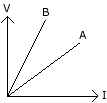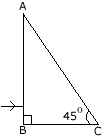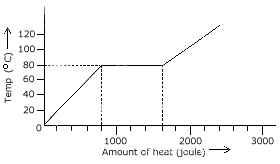(Physics) ICSE Class X Important Questions : Physics (2007)
Disclaimer: This website is NOT associated with CBSE, for official website of CBSE visit - www.cbse.gov.in
Paper : ICSE Class X Important Questions : Physics (2007)
General Instructions:
- Section I is compulsory. Attempt any four questions from Section II .
- The intended marks for questions or parts of questions are given in brackets [ ].
SECTION I (40 Marks)
Attempt all questions from this Section
Question 1
(a) Which class of levers has a mechanical advantage always greater than one? What change can be brought about in this lever to increase its mechanical advantage? [2]
(b) Two bodies A and B of equal mass are kept at heights 20 m and 30 m respectively. Calculate the ratio of their potential energies. [2]
(c) What is the S.I. unit of upthrust? Mention one factor on which the upthrust of a liquid depends. [2]
(d) Why are infra-red radiations preferred over ordinary visible light for taking photographs in fog? [2]
(e) Define Relative density of a substance. [2]
Question 2
(a) Mention two reasons why water is not suitable barometric liquid. [2]
(b) State Snell's Law of Refraction of Light. [2]
(c) (i) What will be the color of a blue flower when it is seen in magenta colored light.
(ii) Name another secondary color of light in which the flower will show the same color as it shows in the magenta colored light. [2]
(d) The upper blood pressure of a patient is 160 cm of mercury whereas the normal blood pressure should be 120 cm of mercury. How much extra pressure is generated by the heart above the normal pressure? (Give your answer in S.I. unit.) (Density of mercury = 13600 kg m-3 ; g = 9.8 ms-2) [2]
(e) Draw an approximate graph to show the variation of atmospheric pressure with altitude. [2]
Question 3
(a) Define the terms:- [2]
- Amplitude
- Frequency (as applied to sound waves)
(b) An object is placed in front of a converging lens at a distance greater than twice the focal length of the lens. Draw a ray diagram to show the formation of the image. [2]
(c) Mention one difference between reflection of light from a plane mirror and total internal reflection of light from a prism. [2]
(d) The V-I graph for a series combination and for a parallel combination of two resistors is as shown in the figure below:-

Which of the two, A or B, represents the parallel combination? Give a reason for your answer. [2]
(e) Of the three connecting wires in a household circuit:- [2]
- Which two of the three wires are at the same potential?
- In which of the three wires should the switch be connected?
Question 4
(a) What will an alpha particle change into when it absorbs:- [2]
- One electron;
- Two electrons?
(b) Some hot water was added to three times its mass of cold water at 100C and the resulting temperature was found to be 200C. What was the temperature of the hot water? [2]
(c) Calculate the value of the resistance which must be connected to a 15Ω resistance to provide an effective resistance of 6Ω. [2]
(d) Why are burns caused by steam more severe than those caused by boiling water at the same temperature? [2]
(e) Mention two important properties of a metal that make it a good thermionic emitter. [2]
SECTION II (40 Marks)
Attempt any four questions from this Section
Question 5
(a) (i) Define a kilowatt hour. How is it related to the joule?
(ii) How can the work done be measured when force is applied at an angle to the direction of displacement? [3]
(b) (i)What is the main energy transformation that occurs in:-
- Photosynthesis in green leaves;
- Charging of a battery.
(ii) Write an expression to show the relationship between mechanical advantage, velocity ratio and efficiency for a simple machine. [3]
(c) A block and tackle pulley system has a velocity ratio 3. [4]
- Draw a labelled diagram of this system. In your diagram, indicate clearly the points of application and the directions of the load and effort.
- Why should the lower block of this pulley system be of a negligible weight?
Question 6
(a) (i) Name and state the principle on which the working of a hydraulic machine is based.
(ii) A balloon filled with hydrogen rises to a certain height and then stops rising. Why does it stop rising? [3]
(b) (i) State the Archimedes Principle.
(ii) Explain why a piece of iron sinks in water while a ship made of iron floats. [3]
(c) A piece of wood of volume 200 cm3 and density 0.84g cm-3 floats in a liquid of density 1.05g cm-3 [4]
- What volume of wood will remain above the surface of the liquid?
- What force must be exerted on the wood to keep it totally submerged?
Question 7
(a) The diagram given below shows a right-angled prism with a ray of light incident on the side AB. (The critical angle for glass is 420) [3]

- Copy the diagram and complete the path of the ray of light in and out of the glass prism.
- What is the value of the angle of deviation shown by the ray?
(b) (i) A particular type of high energy invisible electromagnetic rays help us to study the structure of crystals. Name these rays and give another important use of these rays.
(ii) How does the speed of light in glass change on increasing the wavelength of light? [4]
(c) (i) With the help of a well-labelled diagram show that an apparent depth of an object, such as a coin, in water is less than its real depth.
(ii) How is the refractive index of water related to the real depth and the apparent depth of a column of water? [3]
Question 8
(a) A man standing in front of a vertical cliff fires a gun. He hears the echo after 3 seconds. On moving closer to the cliff by 82.5 m, he fires again.This time, he hears the echo after 2.5 seconds. Calculate:- [3]
- the distance of the cliff from the initial position of the man.
- the velocity of sound. [3]
(b) (i) What is meant by Specific heat capacity of a substance?
(ii) Why does the heat supplied to a substance during its change of state not cause any rise in its temperature? [3]
(c) A substance is in the form of a solid at 00C. The amount of heat added to this substance and the temperature of the substance are plotted on the following graph:- [4]

If the specific heat capacity of the solid substance is 500J/kg0C, find from the graph:-
- the mass of the substance;
- the specific latent heat of fusion of the substance in the liquid state.
Question 9
(a) (i) What is meant by earthing of an electrical appliance? Why is it essential? [3]
(ii) What will be the effect on the working of an electrical bell if instead of a direct current, an alternating current is used?
(b) (i) State two factors on which the strength of an induced current depends. [3]
(ii) When a solenoid that is carrying current is freely suspended, it comes to rest along a particular direction. Why does this happen?
(c) A cell of 1.5 V and internal resistance 1.0 Ω is connected to two resistors of 4.0 Ω and 20.0 Ω in series as shown in the figure:- [4]

Calculate the:-
- current in the circuit.
- potential difference across the 4.0 ohm resistor.
- voltage drop when the current is flowing.
- potential difference across the cell.
Question 10
(a) Name the three main parts of a hot cathode ray tube. Mention one important function of each of the three main parts. [3]
(b) (i) State the principle on which the functioning of a nuclear reactor is based.
(ii) Name the material that can be used as fuel in a nuclear reactor.
(iii) How is the activity in a nuclear reactor controlled?[3]
(c) (i) What happens to the atomic number of an element when it emits:- [4]
- an alpha particle;
- a beta particle.
(ii) Explain why alpha and beta particles are deflected in an electric or a magnetic field but gamma rays are not deflected in such a field.